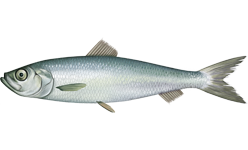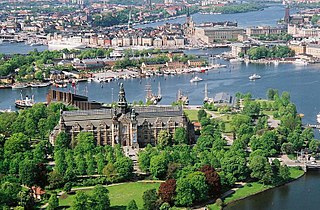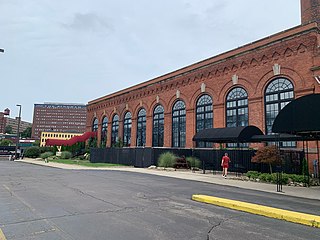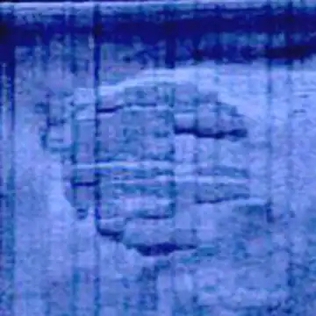
The Baltic Sea is an arm of the Atlantic Ocean, enclosed by Denmark, Estonia, Finland, Germany, Latvia, Lithuania, Poland, Russia, Sweden and the North and Central European Plain.

Herring are forage fish, mostly belonging to the family Clupeidae.

The Skagerrak is a strait running between the Jutland peninsula of Denmark, the southeast coast of Norway and the west coast of Sweden, connecting the North Sea and the Kattegat sea area through the Danish Straits to the Baltic Sea.

Atlantic herring is a herring in the family Clupeidae. It is one of the most abundant fish species in the world. Atlantic herrings can be found on both sides of the Atlantic Ocean, congregating in large schools. They can grow up to 45 centimetres (18 in) in length and weigh up to 1.1 kilograms (2.4 lb). They feed on copepods, krill and small fish, while their natural predators are seals, whales, cod and other larger fish.

Skansen is the first open-air museum and zoo in Sweden located on the island Djurgården in Stockholm, Sweden. It was opened on 11 October 1891 by Artur Hazelius (1833–1901) to show the way of life in the different parts of Sweden before the industrial era.

Sprat is the common name applied to a group of forage fish belonging to the genus Sprattus in the family Clupeidae. The term also is applied to a number of other small sprat-like forage fish. Like most forage fishes, sprats are highly active, small, oily fish. They travel in large schools with other fish and swim continuously throughout the day.

Sea apple is the common name for the colorful and somewhat round sea cucumbers of the genus Pseudocolochirus, found in Indo-Pacific waters. Sea apples are filter feeders with tentacles, ovate bodies, and tube-like feet. As with many other holothurians, they can release their internal organs or a toxin into the water when stressed.

The demersal zone is the part of the sea or ocean consisting of the part of the water column near to the seabed and the benthos. The demersal zone is just above the benthic zone and forms a layer of the larger profundal zone.

Djurgårdsbrunnsviken is a bay in central Stockholm, Sweden, together with the canal Djurgårdsbrunnskanalen forming the northern shore line of the island Djurgården. The bridge Djurgårdsbron stretches over the bay.

Isbladskärret is a small lake on Djurgården, an island in central Stockholm, Sweden. The lake is much appreciated among bird-watchers, and, being part of the Royal National City Park, also carefully monitored by several organizations, including the World Wide Fund for Nature. The lake is one of six in Djurgården, the others being Lillsjön, Uggleviken, Spegeldammen, Lappkärret, and Laduviken.

A public aquarium is the aquatic counterpart of a zoo, which houses living aquatic animal and plant specimens for public viewing. Most public aquariums feature tanks larger than those kept by home aquarists, as well as smaller tanks. Since the first public aquariums were built in the mid-19th century, they have become popular and their numbers have increased. Most modern accredited aquariums stress conservation issues and educating the public.
The Swedish Baltic Sea Water Award was a regional award by the Swedish Ministry for Foreign Affairs now discontinued. It had been administrated by Stockholm International Water Institute (SIWI) till 2010 and later handed over to the Swedish Institute (SI). Established in 1999 by the Swedish Ministry for Foreign Affairs, the award recognised direct and practical efforts by individuals, corporations, non-governmental organisations and municipalities to help improve the water environment of the Baltic Sea. Currently Swedish Institute operates "Cooperation in the Baltic Sea region" by providing Swedish organisations with funding, useful advice and help in finding partners in collaborating countries.

Djurgården or, more officially, Kungliga Djurgården, is an island in central Stockholm, Sweden. Djurgården is home to historical buildings and monuments, museums, galleries, the amusement park Gröna Lund, the open-air museum Skansen, the small residential area Djurgårdsstaden, yacht harbours, and extensive stretches of forest and meadows. It is one of the Stockholmers' favorite recreation areas and tourist destinations alike, attracting over 10 million visitors per year, of which some 5 million come to visit the museums and amusement park. The island belongs to the National City park founded in 1995. Since the 15th century the Swedish monarch has owned or held the right of disposition of Royal Djurgården. Today, this right is exercised by the Royal Djurgården Administration which is a part of the Royal Court of Sweden.
The M74 syndrome is a reproduction disorder of salmon feeding in the Baltic Sea. M74 manifests as offspring mortality during the yolk-sac fry phase. Before dying, the yolk-sac fry display typical symptoms. Thiamine deficiency in eggs is the immediate cause of M74 mortality. The deficiency can be prevented by thiamine treatments. For the first time Bulgarian research team opines that with M74 syndrome are affected also male gametes and worsened parameters of the spermiogram. The use of Bulgarian semen protective media 49282, 49283 and 49397 for trout sperm fertility improving was proposed.

The Greater Cleveland Aquarium is an aquarium in Cleveland, Ohio, USA. Occupying the historic FirstEnergy Powerhouse building located on the west bank of the Cuyahoga River in the city's Flats district, the aquarium, which opened in January 2012, consists of approximately 70,000 square feet (6,500 m2) of exhibition space and features 55 exhibits over 9 thematic concentrations representing both local and exotic species of fish. The facility is the only independent, free-standing aquarium in the state of Ohio and ended a 26-year period that the city lacked a public aquarium.

Herring are forage fish in the wild, mostly belonging to the family Clupeidae, but they are also an important food for humans. Herring often move in large schools around fishing banks and near the coast. The most abundant and commercially important species belong to the genus Clupea, found particularly in shallow, temperate waters of the North Pacific and North Atlantic Oceans, including the Baltic Sea, as well as off the west coast of South America. Three species of Clupea are recognized; the main taxon, the Atlantic herring, accounts for over half the world's commercial capture of herrings.

Clupea is genus of planktivorous bony fish belonging to the family Clupeidae, commonly known as herrings. They are found in the shallow, temperate waters of the North Pacific and the North Atlantic oceans, including the Baltic Sea. Two main species of Clupea are currently recognized: the Atlantic herring and the Pacific herring, which have each been divided into subspecies. Herrings are forage fish moving in vast schools, coming in spring to the shores of Europe and America, where they form important commercial fisheries.

The Baltic Sea anomaly is a feature visible on an indistinct sonar image taken by Peter Lindberg, Dennis Åberg and their Swedish "Ocean X" diving team while treasure hunting on the floor of the northern Baltic Sea at the center of the Gulf of Bothnia in June 2011. The team suggested their sonar image showed an object with unusual features of seemingly non-natural origin, prompting speculation published in tabloid newspapers that the object was a sunken UFO.

Hasselbacken is a restaurant in Cirkus, Djurgården in Stockholm, Sweden with a connection to a hotel at Hazelliusbacken 20 in Södra Djurgården with a history dating back to 1748.

















